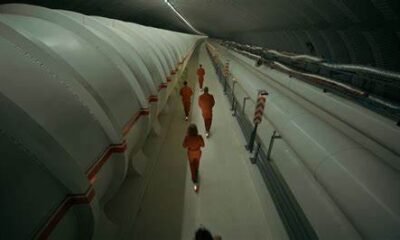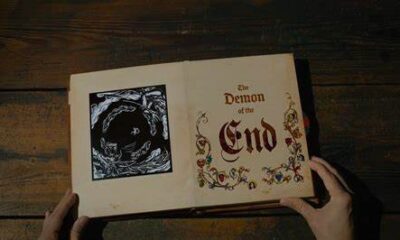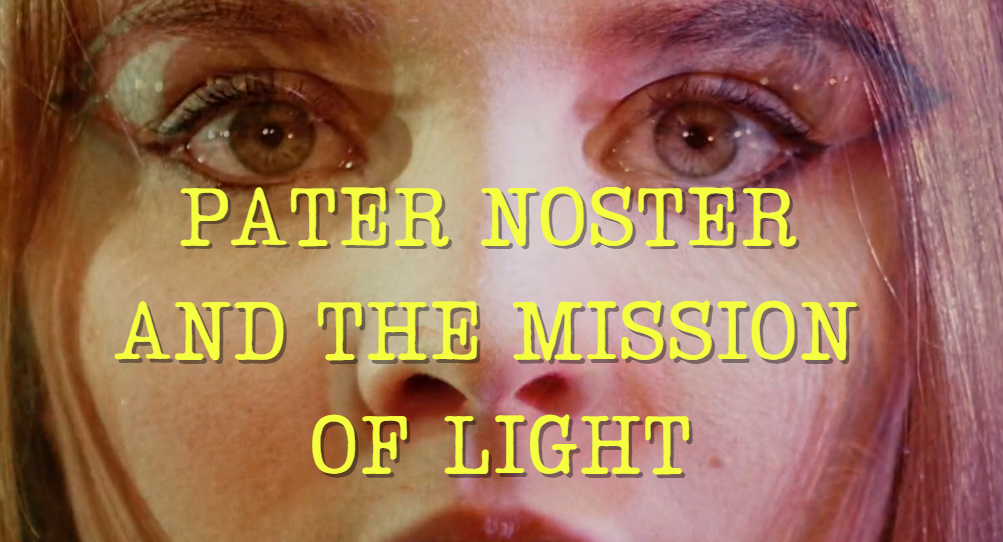
Review: Pater Noster and the Mission of Light (2024)
Disclaimer: This film was given as a screener for the review use of HauntedMTL. You can find more information about PATER NOSTER AND THE MISSION OF LIGHT HERE or buy it on Amazon HERE.
A few years ago, I was talking with a friend and we got on the subject of meditation. I was just getting into it and was looking for some insight.
She’s a smart and well-rounded person, so when she recommended a meditation retreat, I was curious. She described a scenic, rural meditation center within Michigan that hosted weekend-long retreats. Especially silence retreats, where no one speaks at all and meditates for most of the day.
Being a podcast co-host/egoist who loves the sound of their own voice, I was fascinated by the challenge. Perhaps, I, too, could be one of those people who could go without talking for a weekend and become a smart and well-rounded person like her. Perhaps, I, too, could find enlightenment and all that shit.
So, I poked around the website of the retreat and I found something interesting…Music. There on the website were songs created by the meditation teachers. You could even buy their CDs.
“But Brannyk,” you must be thinking, “What does weird meditation music have to do with PATER NOSTER AND THE MISSION OF LIGHT?”
Well, everything.
THE PLOT OF PATER NOSTER AND THE MISSION OF LIGHT
Max (Adara Starr) is a happy-go-lucky and go-with-the flow hipster who works at Hear Kitty Records with boss Sam (Morgan Shaley Renew) and co-worker Gretchen (Shelby Lois Guinn). As she says, “I go where the music takes me.” This proves especially true as a regular comes in with one of the rarest records from Pater Noster and the Mission of Light.
Created by a commune in the 1970’s, this illusive group created multiple albums, most which were lost to time when the group mysteriously disappeared. Now their records are worth thousands, including the very last album they created, said to be cursed. With only four copies made, those who got their hands on the final album supposedly went insane or died.
When Max is miraculously able to get her hands on all copies – all except that last elusive album – she and her friends (including the lovely Sanethia Dresch and the hilarious Joshua R. Outzen) will go to all lengths to find that missing record. Soon they’re tangled in a web of mysticism, music and murder. Will they be able to find out the secrets of the mysterious Pater Noster (Mike Amason) and the Mission of Light in time or will this adventure be their swansong?
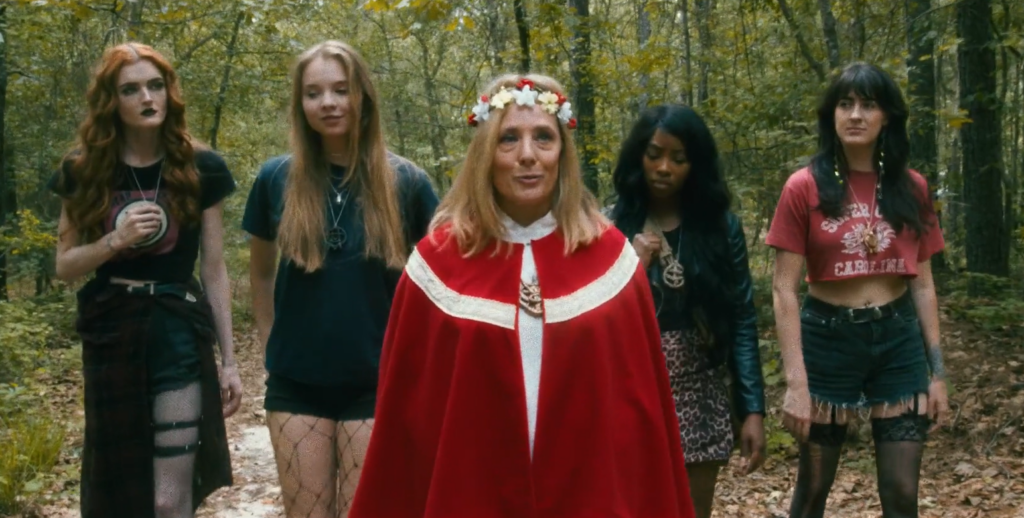
THOUGHTS ON PATER NOSTER AND THE MISSION OF LIGHT
Pater Noster is a strange little gem of a film by writer/director/producer/cinematographer/editor, Christopher Bickel. It’s a love letter to music, records and the weirdos who love underground music. It’s also a strange love letter to the cults who made music in that weird and wonderful time of the 1960’s and 1970’s.
Much like Mandy, there’s a surrealist atmosphere of the cult. Unlike Mandy, the film is gritty and filthy. You rub it between your fingers and there’s sweat and dead skin. It’s manic, raw energy. It’s a bad trip you can’t come down from. A nightmare which you cannot wake. It smells like vomit and fungus-ridden bowling shoes. It’s the worst hangover you’ve ever had.
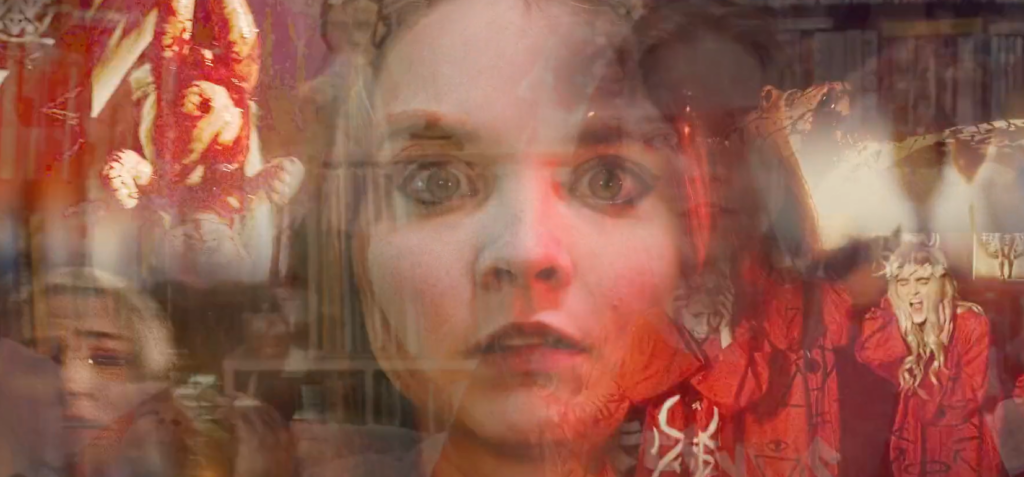
And I mean all this in the best of ways.
The cinematography is an homage to indie films of the 70’s, looking like it was made on super 8 film and sold at an estate sale after being forgotten for years. The effects and makeup are beautifully practical, veering from subtle to ball-to-the-walls, literally puking up your guts. The shit that the crew was able to get away with in terms of action and effects is incredibly inspiring. It easily feels like this is a bigger budget film.
The acting is fantastic for the most part. Joshua R. Outzen as Jay Sin is so funny and honest with his performance. Sanethia Dresch is endearing as Sam’s friend/roommate, and film enthusiast. Morgan Shaley Renew as Sam’s boss is very charming as being like a mother hen for the group. Mike Amason as the eponymous Pater Noster is perfect casting, being able to make the switch from kindly old man to fearsome cult leader .
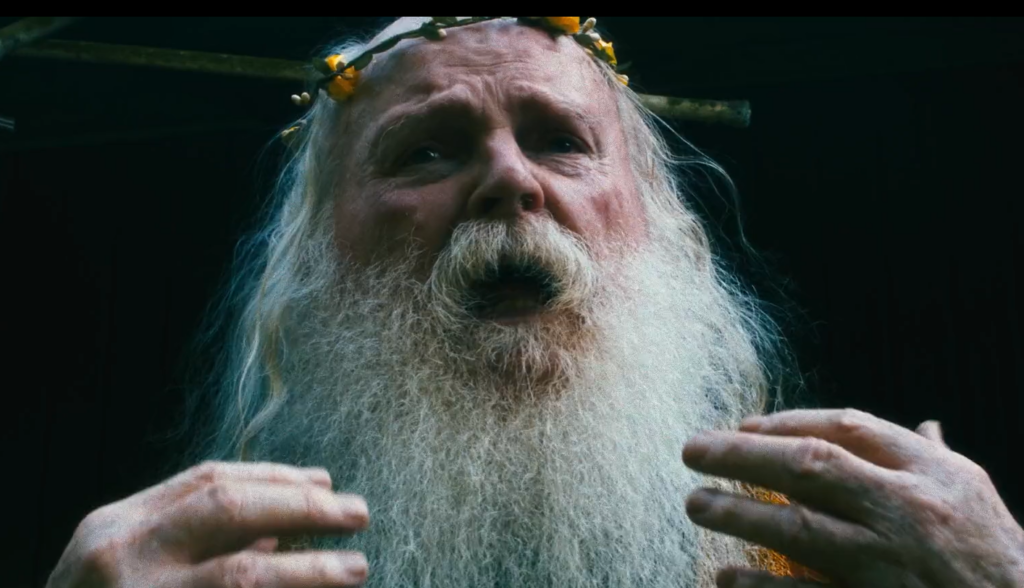
However, I had a hard time getting a read on Max (Adara Starr). She’s just always so happy and go-with-the-flow. Perhaps a bit naive. And maybe that’s the point. She “goes where the music takes her” and there’s little else that motivates her.
The story is clean-cut and follows a simple, but concise narrative. That’s not a bad thing, either. In fact, I prefer the simplicity. It has a clear progression and rising tension. There’s very little to detract from the story or distract the viewer. It’s smartly edited and the pacing is perfect, never meandering off and never throwing everything at you all at once.
The ending is gruesome, chaotic and incredibly satisfying. The finale is beautifully and grotesquely shot. There’s a special balance of avoiding showing too much or not enough, especially with gore and body horror. There’s an art to cutting action just right to make sure the audience is aware of what’s happening, but adding to the tension of the scene. Thankfully, Bickel nailed it with PATER NOSTER AND THE MISSION OF LIGHT.
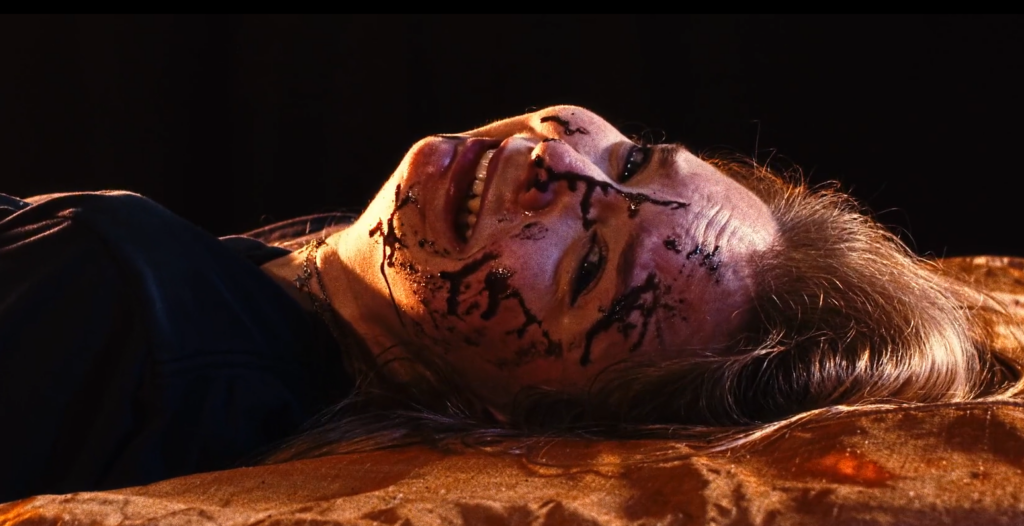
BRAINROLL JUICE:
I have a longer Brainroll Juice for this one (RIP SEO readability), so I’ve set it into two parts – History of Music and Religion and the Cults in the US during the 1960’s-1970’s. Of course, these are just super brief overviews of each and I’m no expert. But I thought it would help with some of the context of my review and also PATER NOSTER AND THE MISSION OF LIGHT.
History of Music and Religion
Religion and spirituality have been intertwined with music since perhaps the dawn of time.
The great goddess Kubile/Cybele was a huge proponent of using music and dance for healing, mental health and spirituality. Dionysus often had raves that lead to prophesies, healings and sexy times.
Meanwhile, the Assyrians used music as a war cry under Ishtar, looking for victory to the beat of cymbals, drums and war-pipes. The Egyptian goddess Isis is said to have created the sistrum (which looks like a wicked torture device). And worshipers of the child-sacrifice-friendly god, Baal-Moloch had priests singing hymns of praise during rituals and sacrifices.

In India, the role of music was relegated to temples, using drums, conches and flutes as instruments to honor the gods. Music was integral in worship and tapping into the realm of the divine. Guy L. Beck explains in Sacred Sound: Experiencing Music in World Religion, “As Brahman pervaded the entire universe, including the human soul at its core, the notion of sacred sound as manifested through chant and music provided a veritable thread binding the human realm to the divine.”
Guru Nanak, the founder of Sikhism, taught through shabads. These were devotional hymns and mantras of the religion, of which many still survive to this day.
And of course, from my boy Rumi, there are the Mawlawīyah, the whirling dervishes, who dance in a religious mystic fervor to prayers and music.
Not to be beat, in the Abrahamic religions’ history, God and music are nearly inseparable. Joshua’s trumpets brought down the walls of Jericho; King David’s wrote and performed numerous psalms; Miriam (Moses’ sister) led a victory song and dance party to celebrate their freedom from the pharaoh.
Obviously, this is a very, very brief overview, but it shows the cultural significance of music of spirituality. Music is an incredibly human and old form of expression, dating back around 40,000 years ago. Songs carry power, our history, spirituality, good omens, and warnings. It’s part of our culture and social learning. We weld our songs reverently, dangerously, softly and loudly.
It’s amazing to think that music today holds just as much joy, expression and spirituality as it did when we as humans didn’t have a written language yet.
Cults in the US during the 1960’s-1970’s
Well, here’s the other half of Bickel’s love letter.
During the rise of religions/cults of the 1960’s and 1970’s, particularly within the United States, music was also critical in their teachings and appeal. Through civil unrest, the rise of drug culture, search for personal identity and the global access to new religions of the East, the American youth sought answers to larger questions. They sought community. Conviction. A place to belong.
From the Beatles getting hippie-dippy with Hare Krishna, to the Helter Skelter of Charles Manson, music and cults also intertwined within this chaotic period.
Cults frequently used music as a means to communicate, to prophesize, to heal and to convert. It’s easy to feel like you belong when you know all the words of the songs and the steps to the dance. You feel like you’re in the “in-group”. Like you, yourself, are part of something larger.
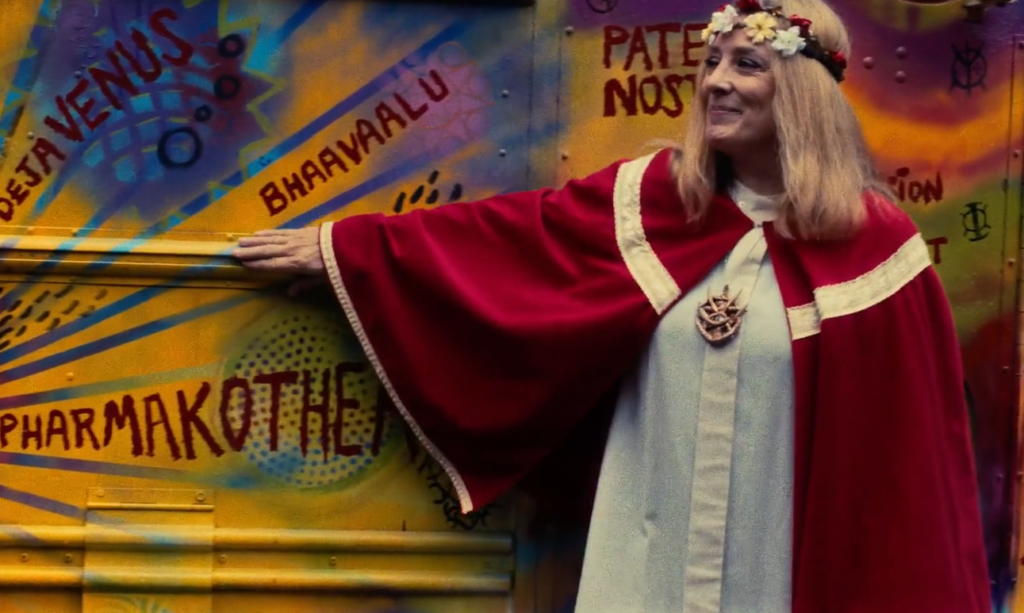
On the Children of God’s website, it states that, “the Children of God became famous as their original music gained popularity when their bands landed recording contracts and big-stage performances, particularly in France and Brazil. From radical rock-style songs denouncing the hypocrisy of the establishment of the day, to heart-touching folk ballads about God′s love, original music became a prominent feature of the movement′s outreach and culture.” They even have a playlist.
The Unification Church (aka the Moonies) have a YouTube channel full of songs, including karaoke versions (worst karaoke party ever).
Bickel created a film that encapsulates the fervor of music and the (sometimes) dangerous allure of spirituality/cults. The quest to find answers and our meaning in the universe. The love of music and its hold on the human soul. The aching desire to be connected with others, with the self, with some kind of higher plane or answer to our questions.
Sam goes where the music takes her; her religion is music. Her worship is through the collection of these records, regardless of the danger associated with it. Not only does she go willingly into the den of Pater Noster, but follows without any suspicion or hesitation.
Pater Noster and the Mission of Light is enticing, with its cheery psychedelic songs, wrapped up in mysticism and mystery. And Bickel showcases this incredibly human desire for something more, for cosmic connection through harmony (literal and metaphorical), and its consequences.
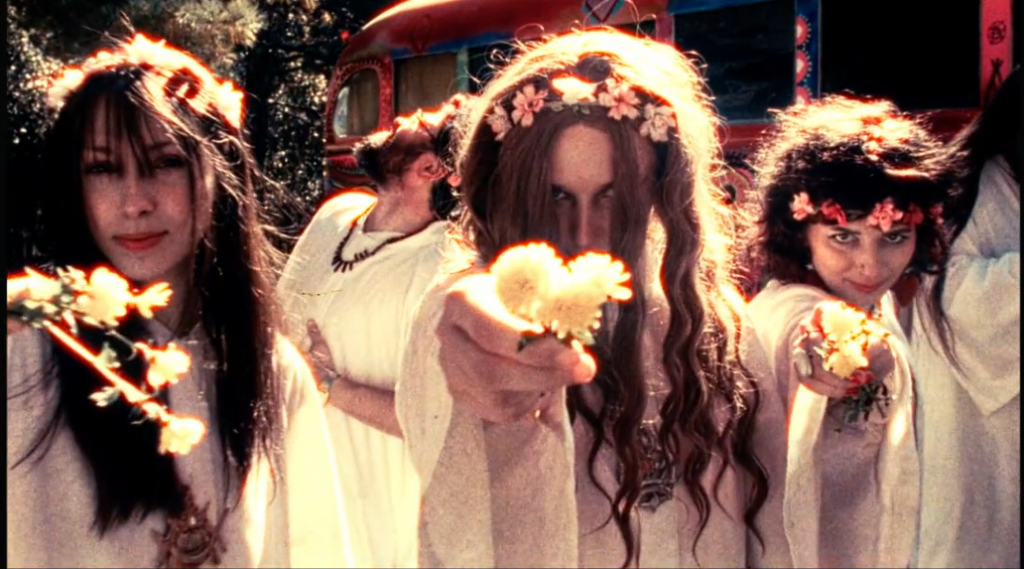
BOTTOMLINE:
It’s Ghost World meets Mandy but dropped on the bloody floor of a mosh pit.
 (5 / 5)
(5 / 5)
PS – Herb Alpert’s Whipped Cream is a FINE album
References:
Treitler, Leo. “History and Music.” New Literary History, vol. 21, no. 2, 1990, pp. 299–319. JSTOR, https://doi.org/10.2307/469254. Accessed 5 Jan. 2025.
Martens, Frederick H. “The Influence of Music in World History.” The Musical Quarterly, vol. 11, no. 2, 1925, pp. 196–218. JSTOR, http://www.jstor.org/stable/738578. Accessed 5 Jan. 2025.
Hansen, Greg (2008) “Sacred Sound: Experiencing Music in World Religions. by Guy L. Beck, editor,” BYU Studies Quarterly: Vol. 47: Iss. 1, Article 16. https://scholarsarchive.byu.edu/byusq/vol47/iss1/16
McLeod, William Hewat and Nangia, Tamanna. “Guru Nanak”. Encyclopedia Britannica, 1 Jan. 2025, https://www.britannica.com/biography/Guru-Nanak. Accessed 5 January 2025.
Britannica, The Editors of Encyclopaedia. “Mawlawīyah”. Encyclopedia Britannica, 15 May. 2012, https://www.britannica.com/topic/Mawlawiyah. Accessed 5 January 2025.
Killin, A. (2018). The origins of music: Evidence, theory, and prospects. Music & Science, 1. https://doi.org/10.1177/2059204317751971
Paglia, Camille. “Cults and Cosmic Consciousness: Religious Vision in the American 1960s.” Arion: A Journal of Humanities and the Classics, vol. 10, no. 3, 2003, pp. 57–111. JSTOR, http://www.jstor.org/stable/20163901. Accessed 5 Jan. 2025.
Movies n TV
Wheel of Time A Question of Crimson Is a Political Espionage Delight
Episode two of Wheel of Time felt like the beginning of a long journey. Stories are unfolding, lives are changing, and blood is spilling.
Let’s discuss.
The story
We begin this episode in the past with Elayne’s mother, Queen Morgase. It turns out her rise to the throne was a bit, shall we say, cutthroat. So when she shows up at the White Tower, Siuan is concerned.
She might have reason to be, too.
Meanwhile, Rand, Egwene, Moiraine, Lan and Aviendha are in the Spine of The World. As they travel through some of the most breathtaking lands I have ever seen on a TV show, Egwene is plagued with nightmares. We think at first that’s just her trauma working itself through her system. But we soon find out that it might not be that straightforward.
Finally, Perrin returns home to heal after his hand is almost cut in half. But when he gets there he finds the town has been infested by Children of The Light. And they’re looking for him.
What worked
There was something heartwarming in this episode about political espionage and choking religious persecution. And that is Elayne’s relationship with her family.
I have consumed a lot of fantasy content with royal families. And I have never once heard a princess call her mother ‘Mum’. I’ve never seen royal siblings get along. And I have sure as hell never seen a princess have a good relationship with her step-parent.
This was refreshing. Even though Queen Morgase is kind of a horrible person she seems like a good mother. And that’s an unexpected delight.

Of course, this is just one storyline among many. And while this can sometimes be overwhelming, in this case it wasn’t.
I’ll be honest, some of these storylines are going to drag for me. I know this because I’ve read some of the Wheel of Time books and I have an idea that not all the characters exactly pique my interest.
No one likes all the characters. No one likes all the storylines. While I am here for the political espionage between Queen Morgase and Siuan, not everyone likes it. While others might be fascinated with Selene trying to win Rand back, I couldn’t care less.
Having multiple storylines keeps everyone’s attention better. So long as things don’t get out of hand. Things can easily get out of hand. But this seems to be managed well.
So far.
What didn’t work
As I mentioned above, I’m not thrilled with Rand’s story at this point. And while it’s fine to not like a storyline when there are this many to choose from, it’s not fantastic that the one I like the least is the one involving our two main characters. And anytime we were with the team at the Spine of The World, the only thing that brought me joy was Moirain’s hat. It reminded me of Stockard Channing’s hat in Practical Magic.
The problem is that Rand is Charlie Brown with controversial magical powers. He is boring, serious, and pessimistic.
And yes, I understand that he has a heavy emotional burden and he’s the Dragon Reborn and that’s quite taxing and all. But let’s be fair, there isn’t a single person in this show that doesn’t have a heavy burden. And most of them manage to be fun occasionally.

All that being said, this episode of Wheel of Time did exactly what it needed to do. It set up conflicts at each of the three locations. It established emotional ties between the characters and the events. And it established goals for everyone.
This was, in short, a solid episode. Not groundbreaking, not mind-blowing or life changing. It was simply good. It was entertaining and moved the plot forward.
Well done.
 (3.5 / 5)
(3.5 / 5)
Movies n TV
Wheel of Time Returns With A Bang
Wheel of Time is back for season three. There are mixed feelings regarding this. Last season, there were some serious pacing issues. And some serious sticking to the book’s storyline issues. But we’re two seasons in, and we don’t give up so easily. So let’s dive into episode one, To Race the Shadow.
By the way, I highly recommend watching this episode with the subtitles on. You’ll see why.
The story
We begin this episode with Liandrin facing a trial of sorts for her rampant betrayal. She does her best to gaslight her Aes Sedai sisters into thinking that Siuan Sanche is the real traitor.

When that doesn’t work, she reveals how many Black Aes Sedai have actually infiltrated the tower.
Spoiler, it’s a lot.
In the aftermath, our whole team gathers to drink and enjoy one night of relaxation before they head out to the Tear to form an army for Rand. All is going well until they’re attacked by myriad creatures and a sentient axe.
What worked
This episode was long. It had a run time of an hour and eleven minutes. And a lot of that run time was spent in heavy dialog scenes.
Fortunately, these were well-done scenes.
If you’re going to have a lot of talking scenes, there are good ways and bad ways to do it. Last season, we saw lots of examples of the bad way to do it. But this episode did it well. For one thing, other things were going on while conversations were taking place. The characters are drinking, playing games, walking through an interesting city. And the scenes themselves didn’t stretch out. They weren’t repetitive. We heard what the character had to say, then we moved on.
It was also nice that the point of these scenes wasn’t just info dumps. We had character development. We had romantic interactions. We had plot development and foreshadowing.
Overall, this episode felt like what it was. A moment of calm before a storm.
Taking a step back, I’d be remiss if I didn’t address the fight scene at the start of the episode. Because it was epic.
The magic looked amazing. The martial arts that went along with it looked fantastic. The costumes were beautiful. It was just incredibly fun to watch.
More than that, it was emotional. We lost some characters in that fight that were important. And it was clearly emotionally shattering for many of our characters, who found themselves betrayed by people they trusted.
So many of them.
It was a great way to open the season.
What didn’t work
Despite that, this episode wasn’t without its flaws.
First off, there were a lot of dialog scenes. And they were good scenes, as I’ve already discussed. But it was one after another after another. And when your episode is, again, an hour and eleven minutes, it’s maybe a little much to have so much chit-chat. Couldn’t some of these conversations, important as they were, have been moved to maybe another episode?
Finally, I want to talk about Egwene’s travel through the arches.

I feel like maybe there were some deleted scenes here. Because there must have been more to that visit than what we saw, right?
We could have seen Egwene battle Rand. That would have been badass and emotionally devastating. We could have seen her with a quiet life with Rand back home at the Two Rivers. We could have seen anything except for the quick clip of Rand in a bloody river, followed by Egwene being shoved back out in a bloody shift.
No products found.
Bad job. But at least it wasn’t an extended scene of Moiraine collecting bathwater, and then taking a bath while looking sad. If we’d started this season with another scene like that, it might have broken my brain.
Amazon dropped the first three episodes at once. So we’ll be back soon to talk about episode two. See you then.
 (4 / 5)
(4 / 5)
Movies n TV
Entertaining as hell: Eight Legged Freaks (2002) Review
Early 2000s is a special era for the industry. It accepts the cheesiness and corniness of movie making, in turn producing some gems in their own right. Eight Legged Freaks starring David Arquette and young Scarlet Johanson is a horror comedy about giant spiders who overtake a small town. As crazy as that premise sounds, the movie surprisingly has a ton of heart and is super entertaining. Let’s review, shall we?
Plot
We start Eight Legged Freaks with a shot of toxic waste spilling into the water supply of Joshua, a spider farm owner. He is friends with Mike, one of our protagonists, who is a science geek and a spider enthusiast. Mike notices something quite right upon visiting Joshua, but no one takes him seriously. We are then introduced to the rest of the crew. Mike’s mother Samantha, the town sheriff, is too busy chasing Ashley, his sister, who is dating the town mayor’s son Bret (something Samantha does not approve of). We also have Chris, who returns to the town to save his father’s legacy in the town mines. He has opposition from Wade, Bret’s father, who wants to use the mines for his business ventures. Lots of drama going on that will only get juicier once the spiders get loose.
The creepy crawlies quickly dispose of Joshua and make their grand appearance after Ashley rejects Bret’s advances, abandoning him in the middle of a desert. A glorious chase sequence ensues as the spiders make their way towards the town, wreaking havoc on its residents. In a true horror fashion (which the movie acknowledges), it takes some convincing from Mike and then from Samantha for the town to take the threat seriously. The tongue-in-cheek style of narrative adds the comedy aspect to a movie that would otherwise burn out fairly quickly.
The remaining characters hide out in a shopping mall as it’s the only somewhat sturdy building in the area. This doesn’t last long as the spiders break in, forcing them to run through the mines. Their resources to fight the creepy crawlies off are limited as the methane gas doesn’t allow them to use firearms. Such conditions require resourceful thinking from Chris, who uses perfume to fend off the leader of the spider group and save himself during the climax of the movie.
Character dynamics are not forgotten once the action kicks in. We have Chris confessing his long-term feelings for Samantha which she knew all along, which provided some comedic relief. Bret also reunites with Ashley and apologises for being an asshole. Mike finally gets the appreciation he deserves as his knowledge saves the townsfolk more than once during the whole ordeal.
We end the movie with the town’s radio show person telling the story as an urban legend during his segment. This brings it into question – how much of it happened the way he said it did? We can only guess…
Overall thoughts
Eight Legged Freaks is a fun creature feature with some self-aware commentary on genre tropes that doesn’t take itself too seriously. The acting is good, the pacing fitting and the characters are likeable enough for you to want them to make it through. Definitely a must watch, if you don’t suffer from arachnophobia, that is.
 (5 / 5)
(5 / 5)
- What do you get when you cross toxic waste with a bunch of exotic spiders? Eaten! The townies of Prosperity, Arizona will all become a screaming smorgasbord if mutated arachnids as big as SUVs have their way in this comedy/horror crowd pleaser whose creators include the producers of Independence Day and Godzilla
- Spiders that leap like gazelles, web-spitting spiders, spiders that suck your insides out as if through a straw—they’re all among the behemoths conjured up by an inventive effects team
- David Arquette (Scream) leads the two-legged stars, mobilizing the citizenry in a last-ditch fight to survive
Last update on 2025-03-10 / Affiliate links / Images from Amazon Product Advertising API


